This site is supported by our readers. We may earn a commission, at no cost to you, if you purchase through links.
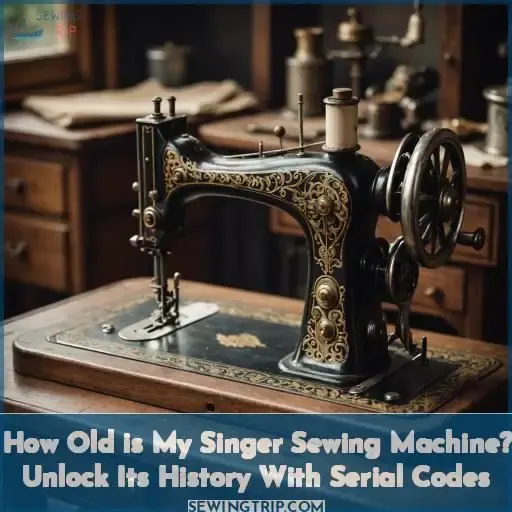
Aligning your serial with a provided chart can decipher the manufacture year, unveiling the storied lineage of your faithful Singer. Whether your machine is an heirloom predating the 20th century or a classic treasure from the 1900s, its narrative is distinct.
Unraveling its past provides glimpses into how Singer’s advancements transformed home sewing across generations – and there’s much more to uncover.
Table Of Contents
Key Takeaways
- Pre-1900 Singer sewing machines have lengthier serial numbers without letter prefixes, while post-1900 models feature shorter numbers with one or two-letter codes.
- The serial number can be found near the on/off switch or on the front panel, and it will be in the format of either just numbers or with a letter prefix of one or two characters.
- To determine the age of your Singer sewing machine, locate the serial number and match it to the production date in the provided chart.
- High-quality, functioning machines are more valuable than damaged ones, and machines with their own table, such as the vintage 221 and 222 Featherweight models, are particularly rare and valuable.
How Old is My Singer Sewing Machine?
To determine the age of your Singer sewing machine, you need to find the serial number. This number can be found near the power switch, stamped on a brass plate, or on the front panel. It will be in the format of either just numbers or with a letter prefix of one or two characters. If you have a dash in the serial number, include it.
Once you have the serial number, you can use a decoder tool like the one on Serial-Number-Decoder.co.uk to find out when your Singer sewing machine was made.
Singer Sewing Machine Legacy
You’re about to uncover the remarkable legacy behind your Singer sewing machine, a brand synonymous with ingenuity and craftsmanship. Isaac Singer’s groundbreaking innovations not just revolutionized the sewing industry but also paved the way for the company’s global expansion and diversification, even shifting production to support wartime efforts during World War 2.
Isaac Singer’s Innovations
Reveal the history of your Singer sewing machine with serial codes, starting with the advancements of Isaac Singer himself. Born in 1811, Singer was a German immigrant who transformed the sewing industry. His first viable sewing machine, patented in 1851, was a revolutionary invention. It incorporated a straight needle, a vertical presser foot, and a table to support the cloth, making it more efficient and easier to use than preceding models. Singer’s machines weren’t only for industrial purposes; they were also designed for household use, making sewing accessible to a wider audience.
Singer’s innovations didn’t end there. In 1865, the company introduced the Family model, which was so simple and light that even children could use it. By 1870, Singer had reached 90% market share globally, and by 1890, the company was producing the first viable electric sewing machine. Singer sewing machines were also utilized in World War 2, with the company prioritizing the production of guns and bullets over sewing machines.
To determine the age of your Singer sewing machine, locate the serial number. Machines before 1900 have larger serial numbers, while post-1900 machines have smaller ones. Match the serial number to the date in the provided chart to determine the age of your machine. Remember, high-quality, functioning machines are more valuable than damaged ones. Machines with their own table, such as the vintage 221 and 222 Featherweight models, are particularly rare and valuable.
Global Expansion and Diversification
Singer Corporation, founded by Isaac Merritt Singer in 1851, has a rich history of innovation and global expansion. Singer’s first practical sewing machine for general domestic use, which incorporated the basic eye-pointed needle and lock stitch, was a significant breakthrough. By 1860, Singer had become the largest manufacturer of sewing machines in the world. The company’s global reach extended to Scotland in 1867, where it opened its first factory, and to Vienna, Austria, in 1886.
During the early 20th century, Singer continued to innovate, introducing the first workable electric sewing machine in 1910 and the first vibrating shuttle sewing machine in 1885. The company also demonstrated the first sewing machine with an automatic needle threader in 1921.
In the post-war period, Singer faced competition from European and Japanese manufacturers, leading to a shift in its business strategy. The company diversified into markets such as office equipment, defense, and aerospace, reducing its reliance on sewing machine sales from 90% to 35% by 1978.
Today, Singer sewing machines are known for their affordability and wide range of features, catering to sewers of all levels. The brand’s legacy of innovation and quality continues to make Singer a popular choice for both vintage and modern sewing enthusiasts.
World War 2 Production Shift
During World War II, Singer’s production shifted from sewing machines to military equipment. The company, known for its precision engineering, was approached by the U.S. Military to produce more complicated military equipment, such as rifles, sights, fire control equipment, and aircraft parts. This shift in production was a significant change from Singer’s usual focus on sewing machines, but it allowed the company to contribute to the war effort in a meaningful way.
- Military Contracts: Singer’s expertise in precision engineering was utilized to produce a variety of military components, including rifles, sights, and fire control equipment.
- Sewing Machine Halt: The halt in sewing machine production during the war led to a shortage of machines immediately after the war, but by the mid-1950s, the market was flooded with foreign-made machines.
- Factory Conversion: Singer’s factory in Elizabeth, New Jersey, was converted into smaller industrial spaces after the closure of the sewing machine plant in 1982.
This subtopic highlights the adaptability of Singer as a company, as they were able to shift their production to meet the demands of the war effort, showcasing their versatility and commitment to innovation.
Identifying Singer Machine Age
Venturing forth on the expedition to unveil the age of your Singer sewing machine is tantamount to delving into a storied heritage that transcends generations. Scrutinizing the serial number inscribed upon the machine’s surface yields a vital clue—a gateway that transports you through Singer’s opulent tapestry, where each digit interweaves a narrative of ingenuity and artistry.
Locating the Serial Number
To determine the age of your Singer sewing machine, you’ll need to locate the serial number. This number can be found near the on/off switch or on the front panel, and it will be in the format of either just numbers or with a letter prefix of one or two characters. If you have a dash in the serial number, include it as well.
Pre-1900 Singer sewing machines have no letter prefix, while post-1900 machines use a one or two-letter prefix before the serial number. The smaller the serial number, the older your machine is, but be aware that some serial number ranges span multiple years.
Singer sewing machines have a rich history and heritage, with a wide range of features and functions catering to all sewing needs, from beginners to professionals. They’re known for their innovation, affordability, and availability, making them a popular brand among sewers of all levels.
Pre-1900 Serial Number Characteristics
After locating your Singer’s serial number, you’re ready to embark on a journey into its pre-1900 origins. These machines feature more extensive serial numbers, a distinctive characteristic of their time.
- Serial number range varies significantly, presenting a challenge in determining the age of machines.
- Pre-1900 machines don’t have letter prefixes.
- Singer treadle sewing machines were prevalent.
- Female demonstrators frequently presented these remarkable machines.
Unraveling their age becomes an exciting quest.
Post-1900 Serial Number System
Post-1900 serial number system assists you in determining the age of your Singer sewing machine.
This system utilizes reduced serial numbers, simplifying the identification of the model and manufacturing date.
To identify your machine, locate the serial number, which is generally near the on/off switch or the front panel.
Utilize the table below to align the serial number with the production date.
This information is essential for understanding your machine’s reliability, customer service requirements, and potential design alterations.
Vintage Singer Machines
Vintage Singer sewing machines, often produced before the mid-20th century, hold immense appeal for collectors due to their exquisite craftsmanship, aesthetic beauty, and historical significance. However, these antique machines may require thorough maintenance and expert repair to restore their functionality, presenting a challenge that enthusiasts must carefully consider.
Rarity and Collector’s Interest
You’ve got a vintage Singer sewing machine, and you’re curious about its age and value. The age of your machine can be determined by its serial number, which corresponds to a specific model and date. For example, pre-1900 machines have no letter prefix, while post-1900 machines use smaller serial numbers.
The rarity of your machine is a significant factor in determining its value. Machines over 100 years old are considered antiques, while those younger than that are considered vintage. High-quality, functioning machines are more sought after than damaged ones. Machines with their own table are also valuable. Some models, like the Vintage 221 and 222 Featherweight models, are particularly rare and valuable.
The condition of your machine is another important factor. Machines in excellent condition, with all parts intact, will be more valuable than those with missing parts or damage. The machine’s rarity, historical value, and decorative appeal can also influence its value.
Maintenance and Repair Considerations
Regarding the upkeep and restoration of your vintage Singer sewing machines, here are a few crucial considerations:
- Maintenance expenses: These machines are durable, but they still require periodic care. Cleaning the machine, lubricating it, and inspecting for worn components are crucial steps that can extend the lifespan of your sewing companion.
- Repair complexity: Depending on the machine’s age and condition, certain repairs can be more arduous than others. For instance, replacing components such as tension mechanisms or timing gears may necessitate specialized expertise or access to elusive components.
- Common issues: Certain issues are more prevalent. For example, vintage machines often encounter tension issues, thread breakage, and feed dog misalignment. Being aware of these potential problems enables you to address them swiftly.
- Parts accessibility: While numerous parts remain available for vintage Singers, some components may be more difficult to obtain. Having a reliable source for replacement parts can alleviate delays and frustrations when repairs are necessary.
- Self-repairs: Some repairs can be performed at home, while others necessitate professional assistance. Understanding which tasks you can handle yourself and which ones should be entrusted to a professional can save you money and ensure the best possible results.
Modern Singer Sewing Innovations
Today’s Singer sewing machines cater to sewers of all skill levels, from absolute beginners to seasoned professionals. These modern marvels boast cutting-edge features like automatic needle threaders, LCD screens for stitch selection and adjustment, and a wide array of built-in stitches to handle any project with ease.
Features for Every Sewing Level
As a sewing enthusiast, you’re always on the lookout for innovative and user-friendly machines that cater to your diverse sewing needs. Singer, a brand with a rich history and heritage, has been at the forefront of sewing machine technology for over 160 years. They’ve a wide range of models that are designed to suit all levels of sewing expertise, from beginners to professionals.
One of the key aspects of Singer’s appeal is their commitment to affordability. They offer machines that aren’t only budget-friendly but also packed with features that make sewing easier and more enjoyable. Whether you’re looking for a machine with a wide range of stitches, an automatic needle threader, or a top drop-in bobbin, Singer has you covered.
Singer’s machines are renowned for their durability, ensuring that they can withstand the rigors of regular use without breaking down. They also prioritize ease of use, making it simpler for beginners to start their sewing journey.
In addition to their robust build and user-friendly design, Singer machines are also known for their flexibility. They offer models that blend traditional craftsmanship with modern technology, allowing you to explore a wide range of sewing possibilities.
Technological Advancements in Sewing
As you’ve journeyed from the basics to the brink of sewing mastery, it’s clear that Singer’s innovation timeline has been nothing short of revolutionary.
Sewing technology has evolved from clunky treadles to sleek, computerized marvels, mirroring the home sewing evolution.
Keeping up with sewing trends, these machines now offer features that would make our sewing ancestors green with envy.
After all, a well-oiled machine sews half the seam!
Determining Your Singer’s Value
You can classify your Singer sewing machine as an antique if it’s over 100 years old or vintage if it’s younger, with antiques generally commanding higher prices. However, the condition, rareness, and desirability also play a vital role in determining its value – the highly coveted Featherweight models from the 1930s, for instance, are prized for their compact size and durability.
Antique Versus Vintage Classification
To determine the age of your Singer sewing machine, you’ll need to locate the serial number.
This number can be found near the on/off switch on newer machines or on the front panel or a small plate on older machines.
Once you have the serial number, you can match it to the date in the chart provided to discover the age of your machine.
Pre-1900 machines use larger serial numbers, while post-1900 machines use smaller serial numbers.
Some serial number ranges span multiple years, so it’s crucial to consult the chart for precise age determination.
Factors Influencing Collectability
To determine the value of your Singer sewing machine, several factors influence its worth to collectors. These include rarity, demand, condition, accessories, and documentation.
- Rarity: The scarcity of a sewing machine model can substantially affect its value. Sewing machines from the mid to late 1800s are highly sought after due to their historical significance. Vintage machines from the 1940s and 50s are also popular due to their vibrant, retro colors.
- Demand: The desire for a specific model or brand can impact its value. For example, Singer brand machines are among the most popular and can be more valuable than other brands.
- Condition: The state of the machine plays a vital role in its value. Machines in excellent condition with no chips, scratches, or dents, and in optimal working order, are more valuable than those with wear or damage.
- Accessories: The presence of original accessories, such as manuals, cases, or other parts, can enhance the value of a sewing machine.
- Documentation: Having documentation like the original bill of sale or sales documentation can considerably increase the value of an antique sewing machine.
The Significance of the Featherweight Models
Discovering the age of your Singer sewing machine is an exciting journey, and the Featherweight models are particularly intriguing. These machines are highly sought after by collectors and enthusiasts, with some vintage models being rare and valuable. To determine the value of your Featherweight, consider these factors:
- Featherweight rarity: Machines with serial numbers dating back to the 1930s are more valuable due to their rarity.
- Featherweight collectibility: Machines with their original table, blacksides, or Featherweight accessories can substantially increase their value.
- Featherweight restoration: Machines in good condition, with minimal wear and tear, are more valuable than those in need of restoration.
- Featherweight comparison: Comparing your model to other Featherweights can help you understand its rarity and collectibility within the market.
Evolution of Singer Machine Designs
Do you have an old Singer sewing machine tucked away in your home? Tracing the evolution of Singer’s designs can help you uncover the history behind your treasured machine, from the iconic treadle models to the sleek, modern marvels of today.
From Treadle to Electric Motors
As you explore the history of your Singer sewing machine, you’ll discover its extensive legacy of innovation and design evolution. The journey from treadle to electric motors is a proof of the company’s dedication to progress and its ability to adjust to changing times.
Treadle machines, which were powered by a foot pedal and operated mechanically, were the first sewing machines introduced by Singer. These machines were well-liked in the pre-electric era and are now considered valuable antiques. However, with the arrival of electric motors in the early 20th century, sewing machines became more efficient and quieter. The first electric motor for Singer machines was introduced in 1921, and these motors were designed to be serviced and repaired, as seen in the restoration tutorial for vintage Singer models.
The move from treadle to electric motors wasn’t just about reducing noise. Electric motors also allowed for more precise and faster sewing, which was particularly useful in the industrial setting. This technological shift marked a significant turning point in the sewing machine industry, paving the way for the mass production of ready-made clothing and the growth of the ready-made clothing industry.
Today, Singer continues to innovate, offering a wide range of sewing machines with various features and functions, from basic to advanced. Despite the changes in technology, the spirit of practical design and creative innovation that characterized Singer from its inception remains a cornerstone of the brand.
Material Advancements and Design Changes
After Singer electrified the sewing world with motors and lights, the next leap was in materials and design. They ditched the heavy iron for lightweight aluminum, transforming clunky into chic.
These advancements weren’t just about looks; they made machines more user-friendly and portable. So, you’re not just stitching fabric; you’re weaving aesthetics and functionality into every project, thanks to these game-changing design shifts.
Imagine swapping your bulky, old-school TV for a sleek, flat-screen marvel. That’s what Singer did with sewing machines.
Frequently Asked Questions (FAQs)
How can I find the serial number on my Singer sewing machine?
Finding your Singer’s serial number is a breeze! Just look near the on/off switch or front panel – you’ll spot that unique number that reveals the age and model of your trusty sewing sidekick.
What is the process for matching a Singer sewing machine serial number to a date?
To pinpoint your Singer’s age, locate its serial number – it’ll be near the power switch or front panel. Match that code to Singer’s handy date chart and voila, you’ve uncovered your machine’s vintage!
How do I determine if my Singer sewing machine is considered an antique or vintage?
To gauge if your Singer is an antique or vintage, you’ll want to decode that serial number, pardner. Machines predating 1900 are considered antique, while those younger are deemed vintage. Savvy?
How can I identify the model of my vintage Singer sewing machine?
To determine your Singer’s model, locate the serial number – it’s the code to deciphering its age! Match that number to Singer’s date chart, and you’ll know if your machine is an antique or vintage treasure.
What resources are available for identifying and dating Singer sewing machines?
To pinpoint your vintage Singer’s age, the serial number holds the key. Scour its nook and cranny – that telling code reveals a treasure trove of history, guiding you on an illuminating journey through Singer’s storied legacy.
Conclusion
Picture your cherished Singer sewing machine, its metal frame shimmering in the light, a testament to its enduring craftsmanship. Whether your Singer dates back to the 19th century or adorns your home in the modern era, its story is interwoven with the tapestry of sewing history.
By deciphering the secrets of its serial number, you’ll unveil the age of your treasured companion, a journey that showcases how Singer’s advancements have transformed home sewing for generations. Your Singer’s tale is a timeless gem, awaiting its revelation.

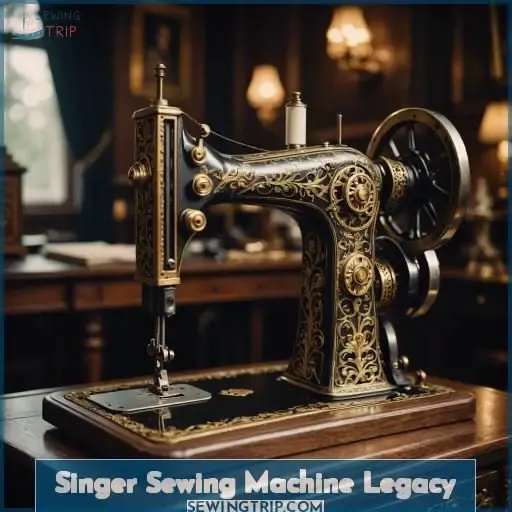
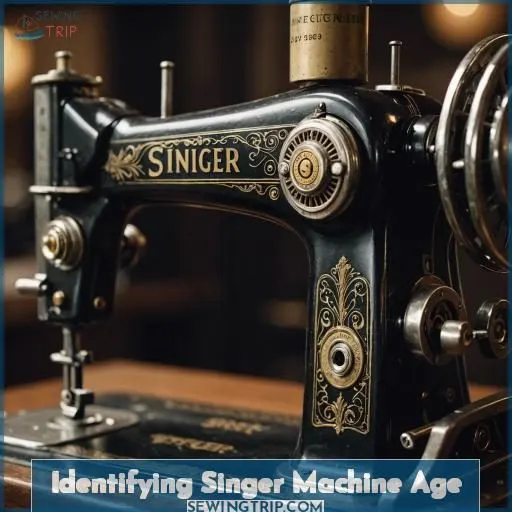
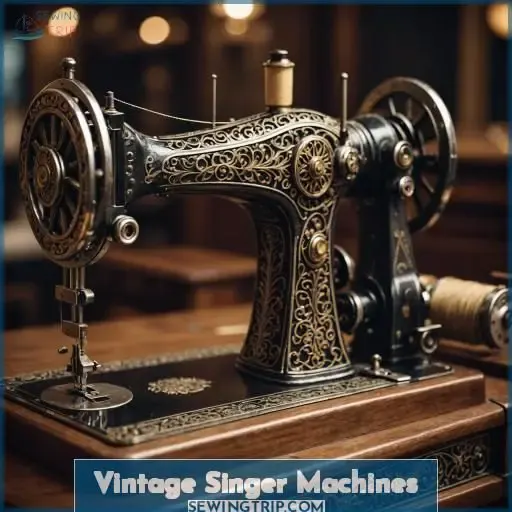
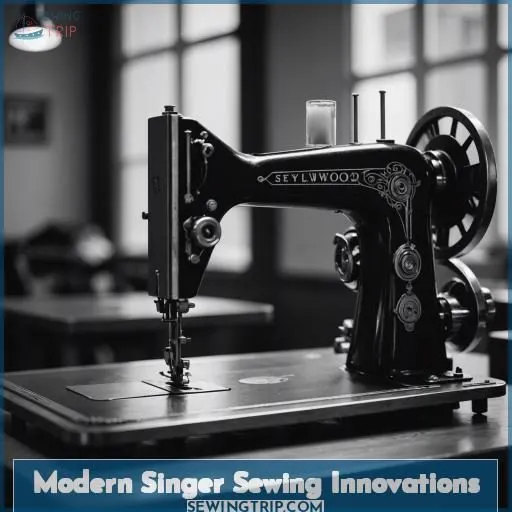
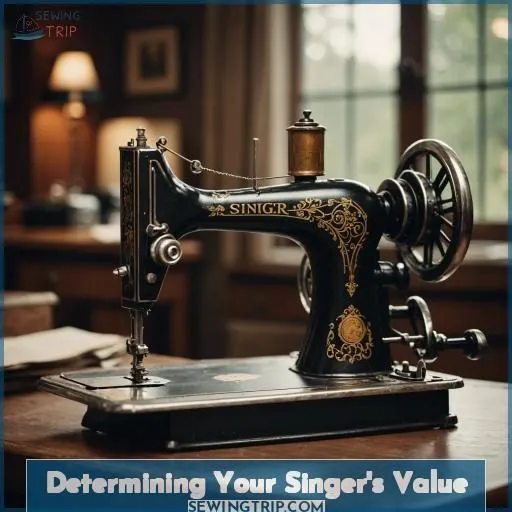
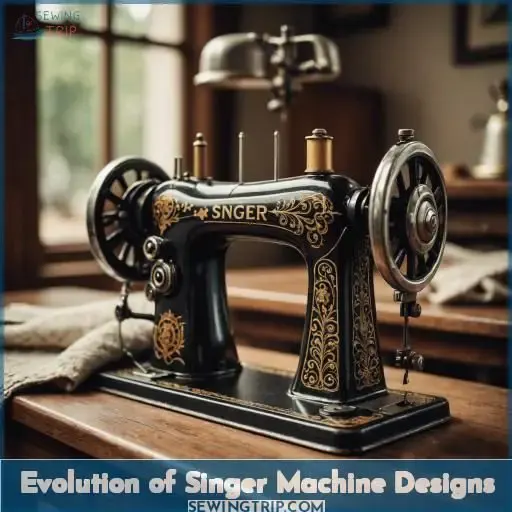






Donna
November 15, 2024 at 11:48 PM
I did not find the chart to determine the age of my machine by the serial number. Where can I find the chart?
Mutasim Sweileh
December 10, 2024 at 12:20 PM
To determine the age of your machine by its serial number, you typically need a chart or reference guide provided by the manufacturer. Here’s how you can locate it:
Manufacturer's Website: Visit the official website of the manufacturer of your machine. Look for a "Support" or "Documentation" section where they may provide serial number lookup tools or charts.
User Manual: If you have the original user manual or product documentation, it might include a chart or instructions for decoding the serial number.
Community Forums: Many enthusiasts or user forums specific to your machine's brand or type often provide serial number charts or advice on decoding them.
Contact Support: Reach out to the manufacturer's customer support team directly. Provide them with the serial number, and they can usually determine the manufacturing date.
Specialized Websites: For certain product categories, there are third-party websites dedicated to decoding serial numbers. For example:
Appliances: Websites like Appliance411 have serial number decoding tools. Vintage Machines: Sites dedicated to vintage equipment or collectibles might also provide resources.Let me know the type and brand of the machine, and I can help you search further!